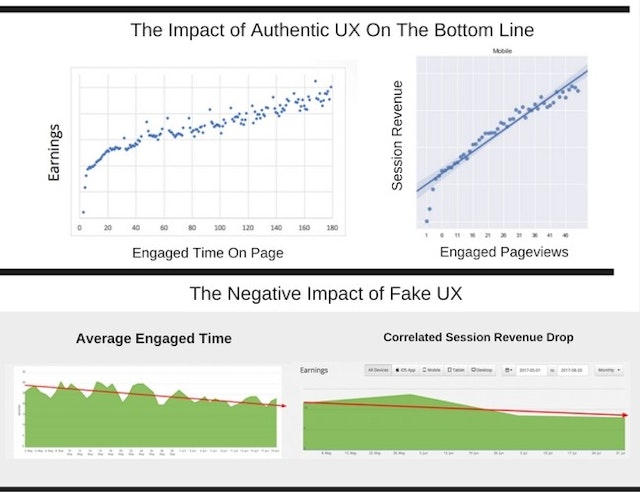The financial impact of fake UX for publishers
Your bounce rate is going down, average session duration and page views per visit are going up. That means user experience is improving on your web property, right?

Where Fake UX comes from and how to spot it
Maybe not.
We are living in the age of Fake UX. As more and more product heads, webmasters, and ops staff run experiments and tests in efforts to deliver better experiences to visitors, publishers are being exposed to a greater and greater risk of artificially inflated user experience metrics.
WTF is Fake UX?
Fake UX is the false generation of improved pageviews per visit and session duration that occurs as a result of something other than a good visitor experience. It makes bounces rates deceivingly lower, and has been proven to cannibalize digital ad revenue and negatively impact organic search traffic.
Where Fake UX comes from and how to spot it
Fake UX can be the result of both intentional and unintentional actions by a publisher — or 3rd party technology providers. The core identifier with with Fake UX is that metrics like bounce rate, pageviews per visit, and session duration are increasing but actual visitor engagement on pages is going down.
So how does this actually happen and how can it be measured? Fake UX generally occurs when the website visitor is spending little time on accidental or undesired pageviews, waiting for pages to load, or struggling with confusing or deceiving elements of navigation.
Example of Fake UX: A new website visitor lands on an article, reads the article, and swipes right on their phone to view some additional content. As soon as the page loads, the visitor realizes this content was not what they wanted to view, and clicks back. Upon returning to the home page, the user quickly decide to close that tab and resume browsing the web on another website. This might show 3 total pageviews, a below average bounce rate, and longer session duration than normal for this type of user, but we know that the additional pageviews and time on site were not the result of visitor engagement, or necessarily of a good experience.
In this case, we’d be seeing an increase in pageviews but a decrease in time on page. When pageviews like this occur, the process is referred to as a navigation bounce.

The financial impact of Fake UX
Since longer user sessions are associated with higher digital revenue, there is a growing desire for publishers to improve UX as a means of driving higher ad earnings. However, research is showing the compounding financial impact of Fake UX. In particular, the impact of low quality pageviews on ad earnings.
Recent data suggests that there is a link between navigation bounces, engagement time, and ad revenue.The mechanism behind this stems from how low-quality pageviews impact advertiser campaigns and publisher page CPMs over time.
If a visitor clicks a link to a new page, then quickly records a navigation bounce back, the pageview produced from that exchange will have extremely low engagement time — meaning the visitor has actually not engaged with the content on this page. If this becomes a common occurrence, you can expect the ads on that page to have low viewability, low CTR, and poor campaign performance metrics for the advertisers. Over time, this will have a devastating impact to that page’s ad rates. As advertisers will both — programmatically and directly — adjust bids on that publisher’s website according to their goals (again, CTR, Viewability, performance). If the same issue occurs across multiple pages, a publisher’s entire site could be negatively impacted.
What’s more, advertisers that see these problems as systemic, will choose to blacklist sites that produce these types of results. Ultimately, this all dilutes ad value on pages affected by Fake UX and can have long-lasting — and sometimes permanent — effects on publisher revenue if these issues are not quickly identified.
Safeguarding against Fake UX
One of the best way to safeguard against these challenges is to monitor navigation bounces and track actual Engagement Time site-wide, by page, and by landing page (instead of just session duration and pageviews per visit). Publishers can also closely watch the relationship between pageviews and time on page.
Testing platforms for publishers, like Ezoic, have built-in intelligence and reporting tools for publishers that break down these metrics so that they can protect themselves against Fake UX. Publishers interested in monitoring this type of information can try Ezoic out at no-cost.
By Tyler Bishop, Head of Marketing, Ezoic
Content by The Drum Network member:

Ezoic
Find out more